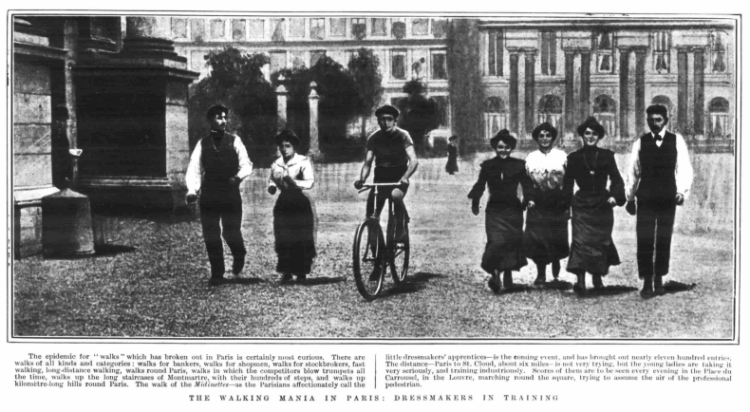Phonetically and semantically similar to milliner, the French word midinette was defined as “a milliner’s female assistant, especially in Paris” in the 1933 Supplement to the New English Dictionary (as the Oxford English Dictionary was known).
However, while milliner literally means a Milanese, a native or inhabitant of Milan, midinette is a portmanteau word, composed of midi, midday, and dînette, light dinner, with reference to the short break taken at lunchtime. The noun dînette is from dîner, a dinner, and the diminutive suffix -ette.
In Ménilmontant (1939), the French singer Charles Trenet (1913-2001) used midinette in its etymological sense:
Quand midi sonne
[…]
La midinette
Fait sa dînette au bistro.
translation:
When midday strikes
[…]
The midinette
Has her light dinner at the bistro.
It is generally said that, in French, midinette is first recorded Le Journal amusant of 17th May 1890, in a caption to a drawing by Henriot:
LA SORTIE A MIDI : Une heure pour déjeuner chez le ’chand de vin ; un hareng, deux sous de frites … Très gentilles, les petites midinettes.
translation:
COMING OUT AT MIDDAY: One hour to have lunch at the wine (mer)chant’s; one herring, two sous’ worth of chips … Very nice, the little midinettes.
However, I have discovered in The Standard (London) of Monday 21st October 1878 that Midinette was the name of a race horse belonging to a Mr J. Page, which had taken part in the Chantilly autumn meeting, near Paris, the previous day.
Very early, midinette took the additional sense of a simple and frivolous young girl, naively sentimental (it is now the only meaning of the word). This is first recorded in Le Pénitencier (1922), the second part of Les Thibault, by the French novelist Roger Martin du Gard (1881-1958):
« Je me suis monté la tête comme une midinette », se disait Antoine en marchant.
translation:
“I got all worked up like a midinette”, Antoine was saying to himself while walking.
The first use of midinette in English that I have found is from The Graphic (London) of Saturday 24th October 1903:
THE WALKING MANIA IN PARIS: DRESSMAKERS IN TRAINING
The epidemic for “walks” which has broken out in Paris is certainly most curious. There are walks of all kinds and categories: walks for bankers, walks for shopmen, walks for stockbrokers, fast walking, long-distance walking, walks round Paris, walks in which the competitors blow trumpets all the time, walks up the long staircases of Montmartre, with their hundreds of steps, and walks up kilomètre-long hills round Paris. The walk of the ‘Midinettes’—as the Parisians affectionately call the little dressmakers’ apprentices—is the coming event, and has brought out nearly eleven hundred entries. The distance—Paris to St. Cloud, about six miles—is not very trying, but the young ladies are taking it very seriously, and training industriously. Scores of them are to be seen every evening in the Place du Carrousel, in the Louvre, marching round the square, trying to assume the air of the professional pedestrian.
In the sense of a seamstress in a Parisian fashion house, French also had:
– cousette, from the stem of a conjugated form of the verb coudre, to sew, and the diminutive suffix -ette
– grisette, from the adjective gris, grey, probably because these seamstresses wore clothes made from cheap grey fabric.
These terms for seamstress, like midinette, are now obsolete. They have been replaced by petite main, literally small hand.
Because the midinettes and grisettes were reputedly sexually promiscuous, they were associated with the lorettes, women of the demi-monde who, in the mid-19th century, lived mainly near Notre-Dame-de-Lorette, a church in the 9th arrondissement of Paris.

